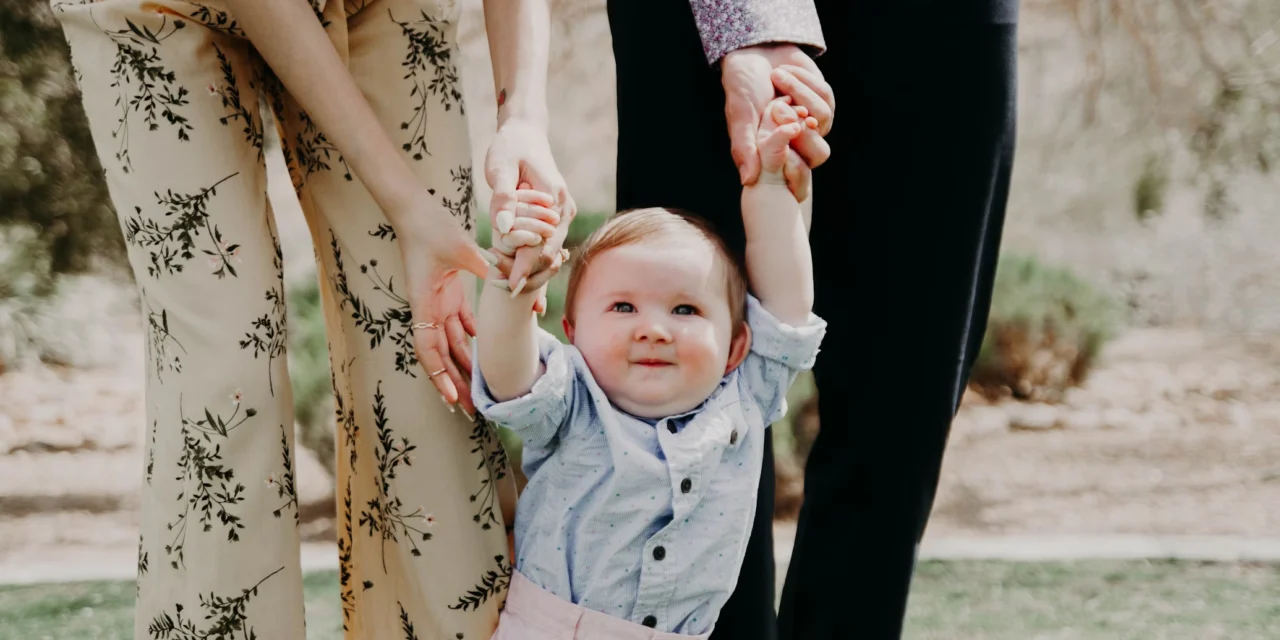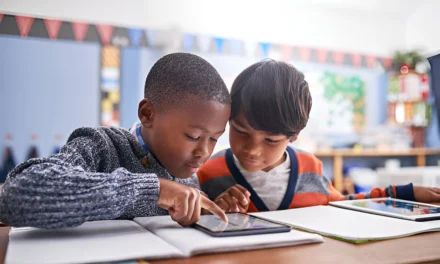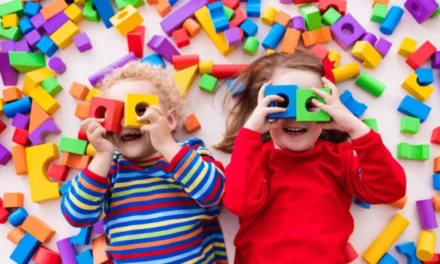As a new parent, you might feel both excited and a bit scared. Watching your child grow and develop is a special time. Each milestone, from the first smile to the first steps, shows your child’s progress and potential. But, understanding early childhood development can be tough.
It’s key to know the milestones that mark important growth stages from birth to age five. In New York, I talked to Dr. Emily Walton, a top pediatrician with over 15 years of experience. She shared a story that shows why knowing about early childhood development is so important.
“A young couple came to me worried their toddler wasn’t meeting milestones,” Dr. Walton said. “After checking, we found a simple diet change and some therapy helped. Seeing their relief was a powerful reminder of the importance of staying informed about these stages.”
Dr. Walton’s words really hit home. Research shows that milestones cover many areas, like speech, dressing, and fine motor skills1. Knowing these milestones is key because children grow at their own pace. Many things can affect their growth, like genetics, nutrition, and environment1.
Key Takeaways
- Early childhood development covers important stages from birth to age five, including cognitive, social, emotional, speech, and motor skills.
- Parents and caregivers are crucial in supporting children’s growth through these milestones.
- Understanding these stages helps spot potential delays and ensures children get the right support.
- Growth charts track children’s progress, with different charts for different ages and conditions.
- Factors like milestones, health signs, family history, and growth patterns can help spot issues early.
Understanding Early Childhood Development
Early childhood development is key for a child’s future. It covers physical, cognitive, social, and emotional changes from birth to age five2. Knowing these areas helps parents, educators, and professionals support children’s well-being.
Definition and Importance
Early childhood development is about the fast changes young children go through in their first years2. This stage shapes their brain, setting the stage for learning, behavior, and health for life3. Quality early learning experiences can greatly impact a child’s future success.
Key Areas of Development
The main areas of early childhood development include:
- Cognitive skills: Learning, problem-solving, and thinking critically4.
- Social-emotional skills: Interacting with others and managing emotions4.
- Speech and language: Talking, vocabulary, and early reading skills2.
- Fine motor skills: Using small muscles, like in hands and fingers2.
- Gross motor skills: Using big muscles, like coordination and balance2.
These areas are linked and vital for a child’s development and happiness3. Supporting growth in these areas helps children meet important milestones.
“The first few years of life are a period of incredible growth in all areas of a baby’s development. A newborn’s brain is about 25 percent of its approximate adult size. It doubles in size in the first year and keeps growing to about 80 percent of adult size by age 3.”2
By grasping the definition, importance, and key areas of early childhood development, we can better support children’s growth and well-being.
The First Year: A Foundation of Growth
The first year of a baby’s life is very important. It’s a time for physical, cognitive, and social-emotional growth. Infants reach many milestones that help them grow and learn more in the future5.
Physical Milestones
In the early months, babies start to develop their physical skills. They learn to hold their heads up, roll over, and crawl. By 12 months, many take their first steps, which is a big achievement in their motor skills5.
Cognitive Milestones
Cognitively, babies quickly get better at focusing on objects and recognizing words. From birth, they start to understand speech sounds, which helps them learn language6. As they grow, they begin to understand the world around them, which is key for learning6.
Social-Emotional Development
The first year also brings big changes in a baby’s social-emotional growth. They start to show different facial expressions and cry to get their needs met. By 18 months, they may show love, want to please others, and start to be independent5.
It’s important to have a safe and engaging place for a child to grow. Quality caregivers should do interactive activities, use the right discipline, and encourage exploration5.
“The first 18 months of a child’s life involve significant development in sensory exploration and motor skills.”5
| Age | Cognitive Milestones | Social-Emotional Milestones |
|---|---|---|
| Birth to 6 months | Focuses on objects, recognizes familiar faces and voices | Cries to communicate needs, responds to soothing |
| 6 to 12 months | Imitates actions, understands simple words | Plays with others, shows affection |
| 12 to 18 months | Follows simple instructions, points to desired objects | Demonstrates independence, wants to please others |
The first year is crucial for a baby’s future growth. It’s a time of big milestones in physical, cognitive, and social-emotional areas. By supporting these stages, parents and caregivers help babies thrive and reach their full potential56.
Techniques to Teach Gratitudeto Your56
Language Development Milestones
The journey of language development starts with simple cooing noises in infancy. It moves on to first words and more7. Children grow at different rates in speech and language skills. By 6 months, most babies know the sounds of their native language7.
First Words and Beyond
A typical timeline for speech and language skills is helpful for parents and professionals8. Babies start making different sounds like laughter and cries by 5 months8. By 6 to 11 months, they understand simple commands and start babbling. They might say “ma-ma” or “da-da” without meaning8.
By 18 to 23 months, a child’s vocabulary grows to about 50 words. They try to combine words and use basic pronouns8.
Importance of Communication
Effective communication is key for a child’s social and cognitive growth7. A checklist of milestones helps professionals track a child’s progress from birth to 5 years7. Some children may face developmental language disorder (DLD), which can delay language skills. These children might start talking in their third or fourth year7.
Encouraging Language Skills
To boost language skills, parents should talk to their children often, read aloud, and create a language-rich environment. Research by the National Institute on Deafness and Other Communication Disorders7 aims to improve diagnosis and treatment of speech and language disorders7. Supporting children’s language development helps them grow and thrive.
Motor Skills Development
Early childhood is key for a child’s health. Motor skills, like walking and using tools, help kids grow independent and explore. They are important for a child’s well-being9.
Gross Motor Skills
Gross motor skills use big muscles and are vital for sports. By age 2, kids can kick a ball without falling. By age 5, they can skip and hop better10.
Fine Motor Skills
Fine motor skills need small muscle coordination. They help with drawing and dressing. Kids can draw shapes and use scissors by age 510.
Activities to Encourage Motor Skills
Playing games and doing puzzles helps kids with motor skills. Running and throwing games improve coordination and balance11.
Research shows kids who play more develop skills faster. Dancing and swimming help a lot. Playing with parents also boosts skills and bonding11.
Parents should balance screen time with play. This helps kids with motor skills, thinking, and problem-solving11.
| Gross Motor Skills | Fine Motor Skills |
|---|---|
|
|
Motor skills are vital for kids’ health and growth. Active play and good strategies help kids grow well-rounded91011.
“Motor skills development is not just about physical abilities; it’s a foundation for a child’s overall growth and success.”
Social Skills Development in Early Childhood
Social skills are key for a child’s growth. They help kids interact with others and understand feelings. From a young age, kids move from playing alone to playing together. They learn to share, take turns, and solve problems12.
Play is a big help in learning these skills. It’s a vital way for kids to get better at socializing.
Interacting with Peers
As kids get older, they start to play more with others. They learn to talk, show feelings, and get social clues13. It’s good to encourage them to talk, take turns, and join in group activities13.
Teaching them words for when there’s a problem helps too. It gives them the tools to handle social situations well.
Understanding Emotions
Knowing about emotions is important for young kids13. When they understand their and others’ feelings, they can empathize and connect better14. Parents and teachers can help by talking openly, reading together, and doing role-playing.
This helps kids recognize and share their feelings.
Role of Play in Socialization
Play is a great way to help kids develop social skills13. Activities like dramatic play and games teach kids to take turns and communicate better13. These fun activities also help kids grow emotionally and socially.
“Encouraging positive relationships, communication, empathy, positive interactions, and active play can help foster social skills that benefit children throughout their lives.”
Places like UNIS Hanoi are key in teaching social skills. They offer a supportive environment and focus on social growth. This helps kids succeed in their future relationships and interactions121314.
Cognitive Development Milestones
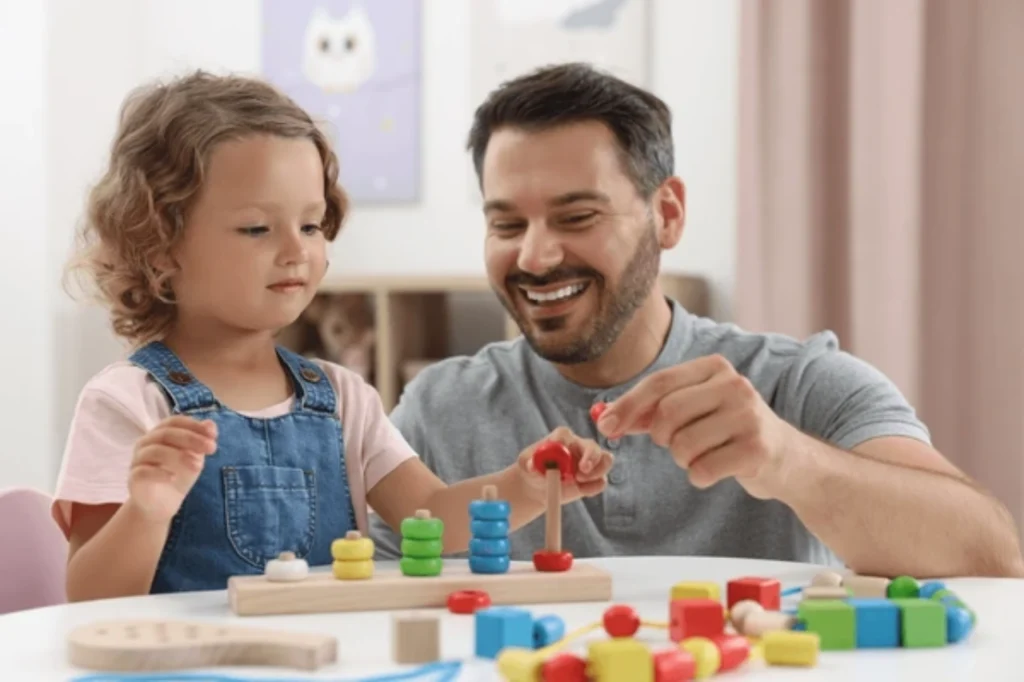
Young children grow fast, and their thinking skills improve quickly. This helps them solve problems, think critically, and learn early academic concepts like numbers and letters15. Their growth is key to understanding the world and learning for life.
Problem-Solving Skills
Infants start showing problem-solving skills early. They begin to root and suck in the first three months15. By 3-6 months, they imitate facial expressions and recognize familiar sounds15.
At 6-9 months, they get better at processing information. They look longer at strange things and understand object differences15.
Critical Thinking Development
Between 1-2 years, children’s thinking skills grow. They enjoy picture books and imitate actions15. By age 3, they ask “why” questions and learn from watching and listening15.
At 4 years, they can draw, count to five, and identify colors15. This shows their growing critical thinking skills.
Number and Letter Recognition
Children start learning numbers and letters early16. By two years, they can name objects in books and sort items15. By age 3, they can count to five and match items by color15.
Playing puzzles and games helps their learning at every stage. A consistent morning routine also supports their growth15. Understanding these milestones helps parents support their children’s development.
“Developmental milestones offer important clues about a child’s developmental health, and looking for them is crucial to understanding a child’s development and behavior.”16
| Cognitive Milestone | Age Range | Example |
|---|---|---|
| Imitation, Facial Expression Recognition | 3-6 months | Imitating facial expressions, reacting to familiar sounds, recognizing familiar faces, and responding to the facial expressions of others |
| Object Differentiation, Relative Size Judgment | 6-9 months | Gazing longer at “impossible” things, differentiating between pictures showing various objects, comprehending differences between animate and inanimate objects, and using relative object size to judge distance |
| Picture Book Enjoyment, Imitation | 12-24 months | Enjoying looking at picture books, imitating simple gestures and actions, manipulating objects by trying to put one into another, and responding with sounds and gestures |
| Questioning, Organization, Matching | 2-3 years | Asking “why” questions to acquire information, showcasing awareness of the past and present, learning by observation and following instructions, and organizing objects by size, shape, and color |
| Drawing, Counting, Color Identification | 4 years | Drawing pictures they name and describe, counting to five, drawing a person’s shape, naming and identifying several colors, rhyming, and indicating where they live |
Developmental milestones are key to understanding a child’s growth16. They help children build a strong foundation for learning and success.
The Role of Parents in Early Childhood Development
Parental involvement is key for a child’s growth in early years. By offering a nurturing environment and joining in their learning, parents greatly influence their child’s development17.
Support and Engagement
Responsive parenting helps children grow well, especially for those at risk17. Studies show that when parents are involved, children show better skills in thinking, socializing, and feeling17.
Creating an Enriching Environment
Having the right toys and learning tools helps children grow18. Children who get lots of early care have bigger brains, which helps them handle stress better17.
Establishing Routines
Regular routines make children feel safe and know what to expect18. When parents respond well and encourage, children listen better and learn more17.
“Responsive parenting, where parents actively engage with their children, has been shown to promote healthy developmental trajectories, particularly for high-risk children.”17
| Key Areas of Parental Involvement | Benefits for Child Development |
|---|---|
| Responsive and Engaged Parenting | Promotes healthy developmental trajectories, increases cognitive, social, and emotional skills17 |
| Providing an Enriching Environment | Fosters growth and development, linked to larger hippocampal volumes and better psychosocial outcomes17 |
| Establishing Consistent Routines | Provides a sense of security, improves emotional and behavioral competence, enhances language development1718, |
Parents play a big role in supporting their children’s growth. They create a caring space for learning and growing1918. Strong bonds and teamwork between parents also help children thrive19.
Emotional Development and Regulation
Emotional growth is key for kids, helping them understand and manage their feelings. As they get older, they learn to see their own emotions and those of others. This helps them develop important self-control skills20.
Understanding Emotions
Babies start to feel basic emotions like joy and fear early on20. As they grow, they learn to tell their feelings apart from others. They start to understand different viewpoints on emotions20. By age four or five, they can even handle mixed feelings, showing they understand emotions deeply20.
Teaching Self-Regulation
Learning to control emotions takes time, and caregivers play a big role. In the first two years, kids rely on adults to help them with their feelings21. As they get older, they start to use these strategies on their own, moving from relying on others to managing their emotions20. By preschool age, they can find ways to handle their feelings, like talking about them or changing the situation20.
The Impact of Parental Attachment
How attached a child is to their parents affects their emotional growth. Kids who feel secure tend to have better emotional control22. When parents respond well, kids adjust better socially and emotionally. But, if parents don’t support them, kids might act out more22. Parents who offer a safe space for learning help their kids grow emotionally strong21.
“Emotional regulation begins with caregiver relationships, setting the foundation for healthy emotional regulation in children in early infancy.”21
| Milestones in Emotional Development | Age Range |
|---|---|
| Development of basic emotions (joy, fear, anger, sadness, surprise, interest) | First year of life |
| Self-referential emotions (pride, shame, compassion, envy, embarrassment, guilt) | End of second year of life |
| Emotional perspective-taking | Second year of life |
| Ability to distinguish own feelings and empathize with others | Ages 3-5 |
| Perception and description of ambivalent emotions | Ages 4-5 |
| Shift from interpsychic to intrapsychic emotion regulation | Ages 2-5 |
Emotional growth and self-control are vital for kids’ well-being. They impact many areas, like social skills and safety. By supporting their emotional development, parents help raise emotionally smart kids21.
Creative Development in Young Children
Helping young children grow creatively is key for their imagination, problem-solving, and self-expression. Activities like open-ended play, art, and music support their growth in many ways23.
Importance of Imagination
Ken Robinson, a famous educator, said everyone is creative. The challenge is to bring out this creativity23. In today’s fast-changing world, kids need to think creatively and adapt23.
Encouraging Creativity Through Play
Play is the best way for kids to learn, boosting their confidence and communication skills. It lets them explore and come up with new ideas23. Lev Vygotsky linked creativity to thinking, saying more experiences mean more imagination23.
Art and Music’s Role in Development
24 Preschoolers gain from activities like drama, music, and art. These help them grow creatively, build confidence, and understand emotions. They also improve their skills in many areas24.
24 Creative activities boost kids’ confidence and creativity. Art and crafts use materials like crayons and playdough for creative expression. Drama and storytelling help with empathy and vocabulary24.
24 Music and dance activities are fun for preschoolers. They learn about rhythm and expression. Adapting activities for different abilities is important24.
Being in a creative environment helps kids grow in many ways. Graham Wallas outlined stages of creative development: Preparation, Incubation, Illumination, and Verification23. Tina Bruce says adults should support children’s creativity by following their lead23.
Children need freedom to take risks and explore. Encouraging creative thinking is key23. Unplanned time and nature play inspire creativity and problem-solving23.
Loose parts play sparks creativity and exploration23. By nurturing creativity in young children, we empower them to reach their full potential23.
“Creativity is as important in education as literacy, and we should treat it with the same status.”23 – Ken Robinson, renowned educator
Cultural Influences on Development
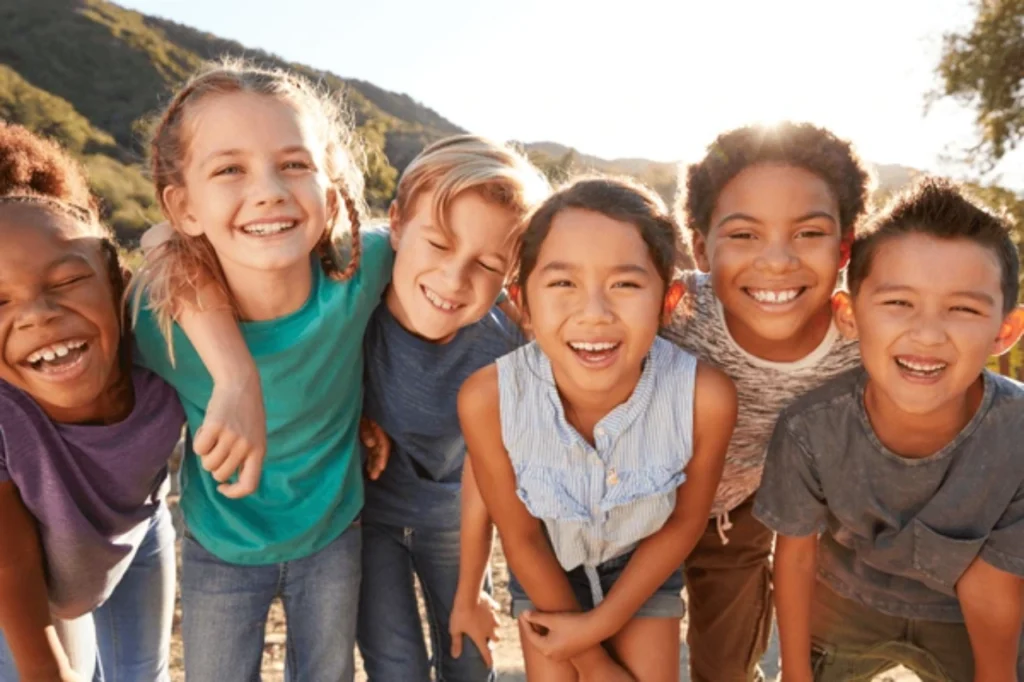
Parenting styles and cultural exposure deeply affect a child’s growth. Parents from different cultures raise their kids in unique ways. These methods reflect the values of their societies25. For instance, parents in some cultures focus on independence, while others stress group harmony25.
Introducing kids to various cultures can boost empathy and global awareness. Studies show that kids exposed to many cultures do better in school. They also develop traits like independence or collectivism based on their upbringing26.
Impact of Diversity in Parenting
The CDC says the first eight years are key for a child’s future. Early childhood shapes learning, health, and success25. Understanding and valuing cultural differences in parenting is vital for effective child-rearing.
Exposure to Different Cultures
Introducing kids to diverse cultures helps them appreciate different views. This exposure can also make them bilingual or multilingual, expanding their cultural understanding26.
Encouraging Inclusivity
Creating an inclusive space where all kids feel valued is essential. The NAEYC warns that exposure to biases can harm young minds. It can affect their self-image and growth25. By promoting inclusivity, we help kids develop self-respect and respect for others, building a fair society.
“The atmosphere a child grows up in, including familial, religious, and community culture, significantly influences a child’s development.”27
Culture is key in shaping a child’s development, affecting how parents and schools teach27. By embracing diversity and inclusivity, we empower kids to grow and understand the world’s rich cultures.
The Importance of Nutrition
Good nutrition is key for a child’s growth, brain development, and health. Starting healthy eating habits early is vital for lifelong health28. It’s important to eat a variety of foods to support growth.
Nutrition’s Role in Development
Nutrition helps with the fast growth and development in early childhood28. Breastfeeding and eating lots of fruits and veggies are good for kids28. Also, making smart food choices early can help prevent obesity, a big problem worldwide28.
Healthy Eating Habits
29 Kids aged 1 to 4 should eat 5 portions of fruits and veggies daily, each about 40g. They should eat carbs for a third of their meals and proteins with every meal. Dairy should be offered 2 to 3 times a day. Getting kids involved in meal planning can make them more excited about eating healthy.
Meal Planning for Children
Planning meals for kids needs careful thought. Parents can get kids involved to make them more interested in healthy food30. Nutrition and early childhood development work together to help kids grow well.
Starting healthy eating early can prevent health problems later, showing how important nutrition is for kids’ long-term health28.
“Proper nutrition during the early years lays the foundation for a child’s physical, cognitive, and emotional well-being.” – Pediatric Nutritionist
Screen Time and Its Impacts
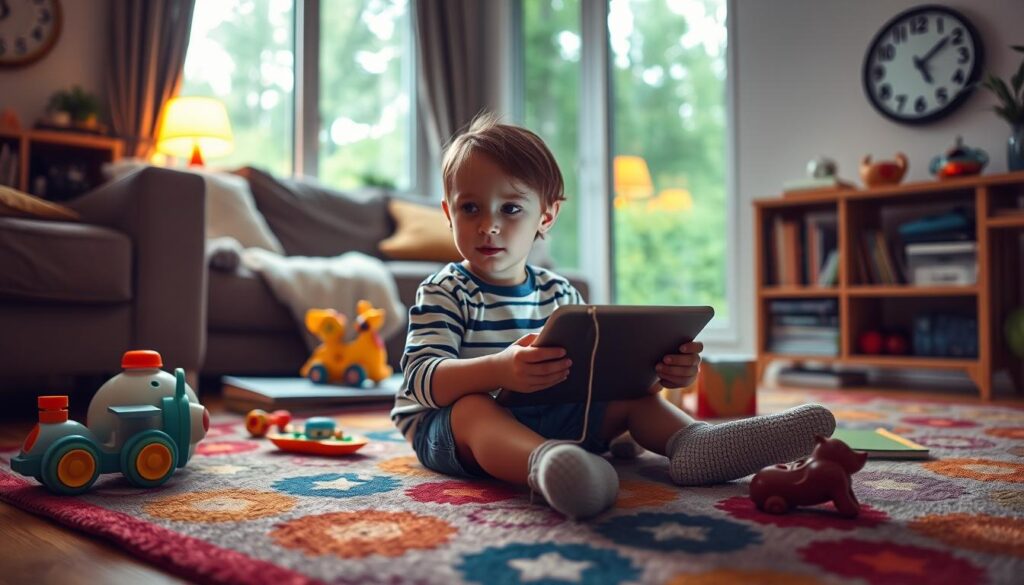
Digital technologies are everywhere, making screen time a big concern for young kids. Studies show that almost half of kids 8 and under have their own tablet. They spend about 2.25 hours a day on screens31. This has raised worries about how screens affect kids’ health and learning.
Recommended Screen Time Guidelines
Health groups have set guidelines for screen use in kids. The American Academy of Pediatrics (AAP) says no screens for kids under 18 to 24 months, except for video calls with family31. For kids 2 to 5, the AAP suggests only one hour a day of quality programming31.
Balancing Screen Time with Activities
It’s important to balance screen time with other activities for kids’ health. Too much screen time can slow down communication and problem-solving skills31. It can also lead to lower grades, bad behavior, and smaller vocabularies32. Caregivers should focus on physical play, socializing, and creative activities for kids’ growth.
Educational Screens vs. Entertainment
Not all screen time is the same. While fun media can be bad, educational content can help kids learn and grow31. Parents and caregivers need to pick the right content for their kids’ needs and goals.
Managing screen time and creating a balanced digital world for young kids is key. By following guidelines, choosing engaging activities, and picking educational media, caregivers can help kids thrive33.
Identifying Developmental Delays
As parents, knowing the developmental milestones is key. Spotting when a child misses these milestones can signal a delay34. These delays can affect many areas, like physical, cognitive, and social skills34. They can also come from brain injuries, genetic issues, or structural problems34.
Signs to Watch For
Developmental delays show up in different ways34. Cognitive delays might happen due to brain injuries or conditions like Down syndrome34. Motor delays can be caused by genetic issues or structural problems34. Social and emotional delays are common, especially in children with autism or ADHD34. Speech delays can be due to various reasons, including brain damage or hearing loss34.
When to Seek Professional Help
If you worry about your child’s development, get professional help35. About 1 in 6 kids in the U.S. face developmental delays35. These delays can affect many areas, like thinking, social skills, and speech35. A child with global developmental delay shows significant delays in several areas35. This is different from lifelong conditions like autism35.
Early Intervention Services
35 Early help is vital for kids with developmental delays3536. These delays are common in young children, affecting 10%–15% of preschoolers36. In some cases, the cause of global developmental delay can be found quickly36. Early action can greatly improve a child’s future36.
36 However, there can be barriers to early detection, like lack of resources or understanding36. Doctors play a big role in spotting these delays early36.
Building Resilience in Young Children
It’s key for kids to learn how to face life’s ups and downs. Parents and caregivers can teach them to cope, use positive words, and solve problems. This helps build a strong base of resilience in young ones.
Teaching Coping Skills
Resilient kids know how to deal with stress and tough times. Adults can show them healthy ways to cope, like deep breathing and positive thinking. By doing this, kids learn to handle challenges better.
Having a caring adult in their life is very important for kids to grow resilient. This adult can offer support and help kids learn to cope with problems.
The Role of Positive Reinforcement
Positive feedback is key in building resilience. When kids feel praised for trying, they feel more confident and in control. This is a big part of being resilient.
Children who face tough times and still do well often have strong bonds with adults. By celebrating their achievements, parents can help kids develop a resilient mindset.
Encouraging Problem-Solving
Resilient kids are good at solving problems. Parents can help by giving them challenges and guiding them through solving them. This boosts their critical thinking and adaptability.
It’s important for kids to learn to handle small challenges first. This helps them grow resilient. When kids solve problems on their own, with support, they feel more confident and in control.
Teaching resilience in young children is vital for their growth. By teaching coping skills, positive reinforcement, and problem-solving, we help kids face life’s challenges and come out stronger.
“Resilience is not something that children either have or don’t have; it involves behaviors, thoughts, and actions that can be learned and developed in anyone.”
– American Psychological Association
Preparing for Transitions
Starting preschool or kindergarten can be both exciting and challenging for young children. It’s important to help them adapt to new environments and manage any separation anxiety they may experience37.
Starting Preschool or Kindergarten
Preparing children for their first day of school is key. Take them on visits to the school, introduce them to the teachers, and discuss the daily routine. This way, they know what to expect37. Also, establish predictable routines at home to provide consistency during this time37.
Adapting to New Environments
Children react differently to new environments based on their temperament and developmental level37. A supportive and flexible approach tailored to their needs can ease the adjustment. Use visual schedules, transition songs, or a supportive peer to help them navigate changes38.
Managing Separation Anxiety
Separation anxiety is common during transitions. Children may struggle to part from their primary caregivers37. Responsive caregiving, clear communication, and gradual acclimation to the new environment can help them feel secure and confident. A positive attitude and modeling appropriate behavior during transitions also have a positive impact38.
By understanding each child’s unique needs and providing the necessary support, parents and caregivers can help young children navigate school transitions successfully. Developing independence in toddlers can also contribute to their adaptability during these important milestones37.
| Transition Support Strategies | Description |
|---|---|
| Consistent Routines | Establishing predictable daily routines can help children know what to expect and boost their self-confidence during transitions37. |
| Visual Schedules | Using visual aids like schedules can help children, especially those with disabilities or suspected delays, understand and prepare for upcoming transitions37. |
| Balanced Activities | Incorporating a mix of active and calm activities in the schedule can make transitions smoother, as physical activity can help children transition between different tasks38. |
| Positive Attitude | Maintaining a positive, calm demeanor during transitions can have a positive impact on children’s experiences, as they often mirror the emotions of adults38. |
“Transitions can be challenging for young children, but with the right support and strategies, they can learn to adapt and thrive in new environments.”
By understanding the unique needs of each child and providing the necessary support, parents and caregivers can help young children navigate school transitions successfully37.
Continuing Development Beyond Early Childhood
Early childhood is key for lifelong learning, but growth doesn’t stop there39. As kids grow older, they face new challenges and chances for growth. Parents, teachers, and communities play a big role in supporting them.
Lifelong Learning
Having a growth mindset and loving to learn are vital for kids to succeed39. By encouraging curiosity, we help them adapt and grow. This way, they can handle the world’s changes and reach their full potential.
Transitioning to Later Childhood
Between ages 9 to 11, kids go through big changes40. They start reading out loud, learn to subtract, and deal with friends40. It’s important to be patient and supportive during these times.
Importance of Ongoing Support
Learning and growth need support from all around39. Parents, teachers, and communities must guide kids through life’s ups and downs39. By doing this, we help all kids thrive and succeed in the long run39. Investing in their education is investing in our future.
FAQ
What are the key areas of early childhood development?
What are some important physical milestones in the first year of a baby’s life?
How do language skills develop in early childhood?
What is the role of play in social-emotional development?
How can parents support their child’s cognitive development?
What is the importance of establishing routines for young children?
How can parents help build resilience in their young children?
What are some signs of developmental delays that parents should look out for?
How can parents help their children transition to new environments, such as starting preschool or kindergarten?
Source Links
- Child Development: Milestones, Ages and Stages – Children’s Hospital of Orange County
- What is Early Childhood Development? A Guide to Brain Development
- Principles of Child Development and Learning and Implications That Inform Practice
- Why Is Early Childhood Education Important for Children?
- Ages and Stages of Development
- Child Development and Early Learning – Transforming the Workforce for Children Birth Through Age 8
- Speech and Language Developmental Milestones
- Age-Appropriate Speech and Language Milestones
- Improving Motor Skills in Early Childhood through Goal-Oriented Play Activity
- Motor Skill Development | Lifespan Development
- Motor Skill Development: A Comprehensive Guide
- Social Skills – Kid Sense Child Development
- Building Social Skills
- Social Development in Preschoolers
- Important Milestones of Cognitive Development in Children
- Training Module 2 | Watch Me! | Learn the Signs. Act Early. | NCBDDD
- The role of parents in early childhood learning | Encyclopedia on Early Childhood Development
- Parenting Knowledge, Attitudes, and Practices – Parenting Matters
- Parenting and Child Development: A Relational Health Perspective
- Strengthening Emotional Development and Emotion Regulation in Childhood—As a Key Task in Early Childhood Education
- Self-Regulation: Emotional Regulation | Illinois Early Learning Project
- Emotional Development in Childhood | Encyclopedia on Early Childhood Development
- Why creativity is important in early child development
- Creative activities for preschooler learning and development
- Cultural Influences on Child Development
- How Can Culture Affect A Child’s Development? – post
- The Role of Culture in Early Childhood Development – Novak Djokovic Foundation
- Adequate Nutrition in Early Childhood
- The Importance of Nutrition in Early Childhood | Partou
- Early Child Development and Nutrition: A Review of the Benefits and Challenges of Implementing Integrated Interventions
- What Does Too Much Screen Time Do to Children’s Brains?
- Effects of Excessive Screen Time on Child Development: An Updated Review and Strategies for Management
- The Impact of Screen Time on Child Development in 2024
- Types of Developmental Delays in Children
- Developmental Delay in Children
- Developmental delay: identification and management at primary care level
- Supporting Transitions Both Big and Small | ECLKC
- Transition Strategies for the Early Childhood Classroom
- Early Childhood Development and Education – Healthy People 2030
- Early Childhood Development: Stages and Key Milestones

